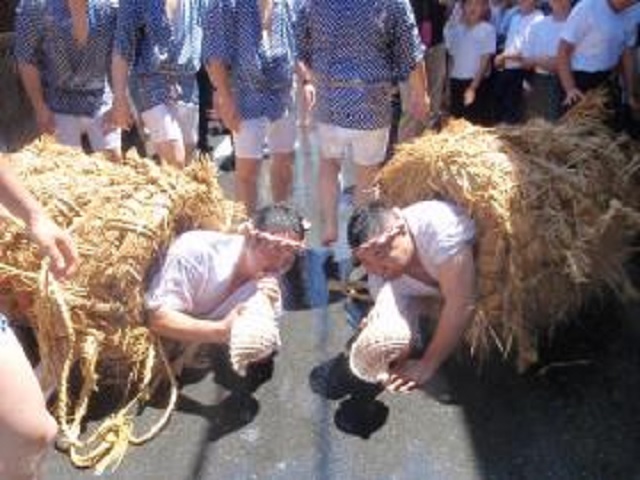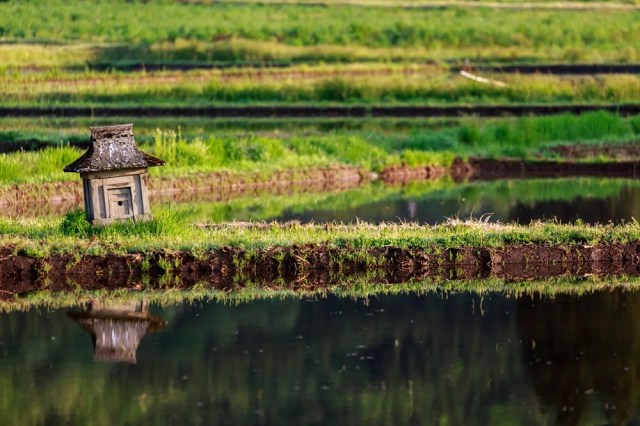Annual Tokyo festival where guys get wrapped in straw and carried through streets returning【Vids】

The story of a drought, dragons, and one of Japan’s craziest festivals.
Once upon a time, there was a village in Japan that desperately needed rain. One thing led to another, and now every year in Tokyo this happens:
大森の水止舞という奇祭をみてきました
— 東京刺激クラブ (@onda3simai4) July 14, 2019
ワラに包まれた人がホラ貝を吹いと引きづられ水をぶっかけられるというエライ目に遭うお祭りですがメタメタ面白かったです☆#東京刺激クラブ #水止舞 #大森 #奇祭 pic.twitter.com/WZ2I4U6HM6
Japan’s summer festivals often have their roots in traditional religious beliefs about the connection between gods, spirits, and forces of nature, and the Mizudome no Mai, which takes place at Gonshoji Temple in the Omori neighborhood of Tokyo’s Ota Ward, is no exception,
Many years ago, or perhaps we should say many, many years ago, since this happened all the way back in 1321, the people of Musashi no Kuni (as east Japan was called in those days) were suffering through a terrible drought. With the earth parched and crops withering, the people turned to the abbot of Gonshoji, asking him to beseech divine forces to bless them with rain.
Hearing the people’s pleas, the abbot constructed a statue of a dragon out of straw, since the creatures have long been associated with water and rainfall in Japanese folklore. The abbot then offered prayers, and before long they were answered, with rainclouds forming and shedding the long-awaited precipitation that ended the drought.

Things seem to have been more or less OK the next year, but the year after that the surrounding community found itself facing the opposite problem. Now there was too much rain, flooding the fields and ruining the efforts of the farmers as much as the drought had. Remembering that, to their knowledge, it was the abbot’s prayers that had brought rain two years prior, some villagers began to resent the priest, speculating that his prayers had been too effective and that they were now suffering the continuing consequences.
So once again, the abbot began crafting animal artwork. He made three lion masks, since the Japanese word for lion is “shishi,” but if written with different kanji characters and read in a somewhat obscure manner, shishi can also mean “stop the rain.”
This time the abbot distributed the masks to the villagers, instructing them to dance, and for others to bang taiko drums or blow into conch shells. This, the abbot said, would pacify the dragon who was causing the ceaseless storms, and once again, his proclamation proved true, as the weather returned to more moderate conditions and the floodwaters receded.

To commemorate this series of events, annually Gonshoji holds the Mizudome no Mai, or “Water-stopping Dance,” and the most dynamic part of the celebration is when two dudes, both usually quite large, are stuffed into cocoon-like straw sacks and carried through the streets of Omori, all while blowing on conch shells and being pelted with water.
【奇祭】男を藁でぐるぐる巻きにして、街中をゴロゴロ転がし、容赦なく水をぶっかける『水止舞』が、東京都大田区大森で7月10日(日)13時~15時開催。ぶっかけられた男はそのたびに法螺貝を吹く。https://t.co/XUHp2lKG1m pic.twitter.com/sUt8Kts1xS
— ほいじんが (@garaguda) June 29, 2022
Those two prone gentlemen represent the storm-bringing dragons, and the townspeople need to transport them to Gonshoji. The dragons, being somewhat rebellious types, won’t make the journey under their own power, and so groups of participants take turns carrying them, periodically dousing them in the creatures’ favorite element, and the blowing of the conch shells is meant to replicate their cries of draconic joy.
こんな感じで運ばれて行きます...
— ドッキリテクスチャー
音が出ますのでご注意下さい
#水止舞 pic.twitter.com/cBGjcrwsFVロコ
(@roko_zan) July 14, 2018
炎天下、藁縄に巻かれ法螺貝を吹く男に水をあびせる奇祭「水止舞」。
— ヤングじぃ (@osamyoung) June 29, 2022
今年度は7月10 日(日)に開催されるようです。前回行った時は簀巻きのコーナーが終わってたので今回は早めに行こう。10日は選挙に行ってからの水止舞だ!https://t.co/M7nNgLPAfh pic.twitter.com/txCkWHVHw0
The Mizudome no Mai takes place in July, and coinciding with the hottest time of the year in Japan means bystanders are only too happy to be hit by stray splashes of water that were aimed at the dragons. Because of the dragons’ weight, frequent stops have to be made, but the procession/carrying has musical accompaniment from flutes and drums, and once the dragons finally do reach the temple, a team of dancers performs while wearing headgear symbolizing the three lion masks made by the abbot for the townspeople during the floods.
▼ You might notice many of the participants wear clothes with a triangular pattern, which is meant to be evocative of a dragon’s scales.
ちなみに #水止舞 は7月14日固定。詳細は公式ホームページを。https://t.co/Sj2HRDHzaa
— やのけん/850 (@tabigarasu24) April 4, 2022
どちらかというと、この獅子舞の前に行われる「道行」の方が“奇祭”として有名ですかね。
縄を巻いた龍神の中に男性が入り、みんなで水をかけまくるという謎の儀式(雨乞い)です。
カメラも濡れます。#大田区 pic.twitter.com/KC1HFt4Jmz
Sadly, the Mizudome no Mai could not be held in 2020 or 2021 due to coronavirus precaution protocols. For 2022, though, the procession will be retuning, with this year’s iteration starting at 1 p.m. on Sunday, July 10.
Temple information
Gonshoji / 厳正寺
Address: Tokyo-to, Ota-ku, Omori Higashi Sanchome 7-27
東京都大田区大森東三丁目7番27号
Source: Mizudome no Mai official website via Hamster Sokuho, Ota Ward
Top image: Ota Ward
Insert images: Pakutaso (1, 2)
● Want to hear about SoraNews24’s latest articles as soon as they’re published? Follow us on Facebook and Twitter!
Credit:




0 comments: